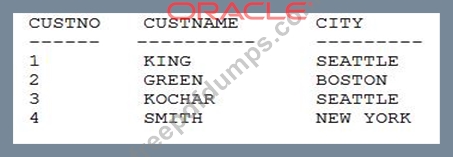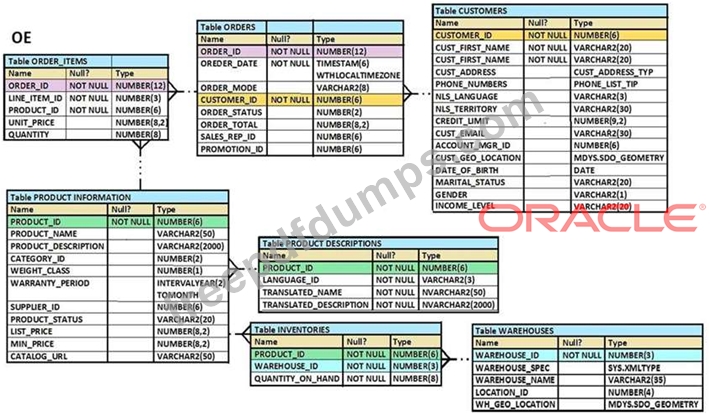1z1-071 Exam Question 1
Examine the data in the CUSTOMERS table:

You want to list all cities that have more than one customer along with the customer details.
Evaluate the following query:

Which two JOIN options can be used in the blank in the above query to give the correct output? (Choose two.)

You want to list all cities that have more than one customer along with the customer details.
Evaluate the following query:

Which two JOIN options can be used in the blank in the above query to give the correct output? (Choose two.)
1z1-071 Exam Question 2
View the Exhibit and examine the structure of ORDER_ITEMSand ORDERStables.

You need to remove from the ORDER_ITEMStable those rows that have an order status of 0 or 1 in the ORDERStable.
Which two DELETEstatements are valid (Choose two.)
DELETE *

You need to remove from the ORDER_ITEMStable those rows that have an order status of 0 or 1 in the ORDERStable.
Which two DELETEstatements are valid (Choose two.)
DELETE *
1z1-071 Exam Question 3
Which three actions can you perform on an existing table containing data? (Choose three.)
1z1-071 Exam Question 4
Examine the create table statements for the stores and sales tables.
SQL> CREATE TABLE stores(store_id NUMBER(4) CONSTRAINT store_id_pk PRIMARY KEY, store_name VARCHAR2(12), store_address VARCHAR2(20), start_date DATE); SQL> CREATE TABLE sales(sales_id NUMBER(4) CONSTRAINT sales_id_pk PRIMARY KEY, item_id NUMBER(4), quantity NUMBER(10), sales_date DATE, store_id NUMBER(4), CONSTRAINT store_id_fk FOREIGN KEY(store_id) REFERENCES stores(store_id)); You executed the following statement:
SQL> DELETE from stores
WHERE store_id=900;
The statement fails due to the integrity constraint error:
ORA-02292: integrity constraint (HR.STORE_ID_FK) violated
Which three options ensure that the statement will execute successfully?
SQL> CREATE TABLE stores(store_id NUMBER(4) CONSTRAINT store_id_pk PRIMARY KEY, store_name VARCHAR2(12), store_address VARCHAR2(20), start_date DATE); SQL> CREATE TABLE sales(sales_id NUMBER(4) CONSTRAINT sales_id_pk PRIMARY KEY, item_id NUMBER(4), quantity NUMBER(10), sales_date DATE, store_id NUMBER(4), CONSTRAINT store_id_fk FOREIGN KEY(store_id) REFERENCES stores(store_id)); You executed the following statement:
SQL> DELETE from stores
WHERE store_id=900;
The statement fails due to the integrity constraint error:
ORA-02292: integrity constraint (HR.STORE_ID_FK) violated
Which three options ensure that the statement will execute successfully?
1z1-071 Exam Question 5
Examine this list of queries:
1. SELECT ROUND (TRUNC (15, 193, 1)) ''Results'' FROM DUAL;
2. SELECT ROUND (15, 193, 1)) ''Results'' FROM DUAL;
3. SELECT (TRUNC (15, 193, 1)) ''Results'' FROM DUAL;
4. SELECT ROUND (ROUND (15. 193, 1)) ''Results'' FROM DUAL;
Which two statements are true?
1. SELECT ROUND (TRUNC (15, 193, 1)) ''Results'' FROM DUAL;
2. SELECT ROUND (15, 193, 1)) ''Results'' FROM DUAL;
3. SELECT (TRUNC (15, 193, 1)) ''Results'' FROM DUAL;
4. SELECT ROUND (ROUND (15. 193, 1)) ''Results'' FROM DUAL;
Which two statements are true?

